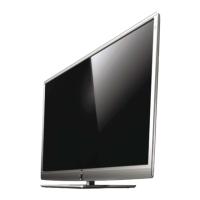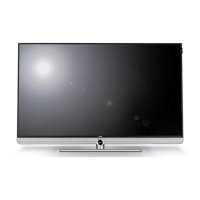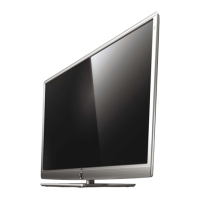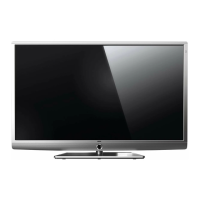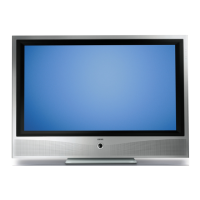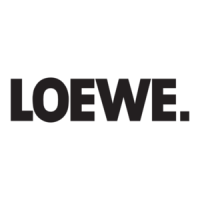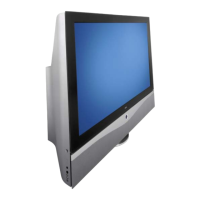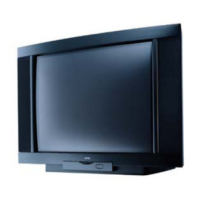Do you have a question about the Loewe Art 42 SL and is the answer not in the manual?
Ensures safe handling of static-sensitive components at dedicated workstations with grounding.
Utilizes conductive plastics for packaging and transport to protect against electrostatic charges.
Covers repair, modification, and testing by qualified persons and VDE standards.
Emphasizes adherence to country-specific safety regulations.
Specifies that components marked with a symbol must be replaced with original parts only.
Pull out the mains plug before proceeding with disassembly.
Loosen and remove marked screws (Type M4 Tx20) to detach the rear cover.
Carefully move the rear cover backwards once the screws have been removed.
Front frame glued with adhesive tape and secured by four Torx screws.
Push frame forward to insert removal tool between frame and panel.
Move tool carefully along panel edges, supporting with gentle pressure.
Move tool horizontally in top/bottom sections, vertically on sides.
Handle the removal tool gently to avoid excessive leverage.
Avoid strong leverage to prevent damage to the display frame.
Illustrates wiring between main components like Signalboard, LCD-Controller, etc.
Shows wiring for the ART 42 SL Full-HD+ 100 model.
Illustrates wiring for the ART 47 SL Full-HD+ 100 / DR+ model.
Depicts wiring for the ART 47 SL Full-HD+ 100 model.
Instructions on how to access the Service Mode using the remote control.
Details on how to call specific alignment functions from the Service Mode.
How to store adjusted alignment values in memory.
Meaning of bits in Byte 0 for TV service adjustments.
Meaning of bits in Byte 1 for TV service adjustments.
Meaning of bits in Byte 2 for TV service adjustments.
Meaning of bits in Byte 3 for TV service adjustments.
Meaning of bits in Byte 4 for TV service adjustments.
Meaning of bits in Byte 5 for TV service adjustments.
Meaning of bits in Byte 6 for TV service adjustments.
Meaning of bits in Byte 7 for TV service adjustments.
Meaning of bits in Byte 8 for TV service adjustments.
Meaning of bits in Byte 9 for TV service adjustments.
Meaning of bits in Byte 10 for TV service adjustments.
Meaning of bits in Byte 11 for TV service adjustments.
Meaning of bits in Byte 0 for DVB service adjustments.
Meaning of bits in Byte 1 for DVB service adjustments.
Meaning of bits in Byte 2 for DVB service adjustments.
Meaning of bits in Byte 3 for DVB service adjustments.
Meaning of bits in Byte 4 for TV service adjustments.
Meaning of bits in Byte 5 for TV service adjustments.
Meaning of bits in Byte 6 for TV service adjustments.
Displays system information and exception handling settings.
Shows configuration options for various bytes.
Settings for colour, sound, and other adjustments.
Displays detailed audio and video information.
Shows subtitle data, system info, and exception details.
Covers mass storage status and common interface settings.
Details option bytes and other adjustment parameters.
Provides detailed information on mass storage ATA status and attributes.
Settings for satellite system configuration and signal sources.
Controls for contrast, brightness, sharpness, and colour settings.
Options for sound modes, speakers, volume, and audio effects.
Settings related to recording timers and wizards.
Guide to selecting connected audio-visual equipment.
Configuration for antenna types and DVB reception.
Setup for speaker systems, including distances and levels.
Detailed settings for satellite antenna setup and LNB frequencies.
Configuration for digital link and remote control features.
Options for manually setting AV standards and audio inputs.
Procedures for searching, updating, and managing TV channels.
Options for selecting, sorting, and managing favourite stations.
Controls for setting preferred language and region.
Settings for locking channels based on age or individual selection.
Setup for recording timers, wake-up alarms, and related functions.
Options for selecting menu, subtitle, and audio languages.
Guides for updating TV software and bootloader.
Configuration for system time, date, and daylight saving.
Controls for displaying information on screen.
Navigating Electronic Program Guide and Picture-in-Picture menus.
Accessing Teletext services and Assist+ functions.
Using PhotoViewer and Digital Recorder menu options.
How to access and operate the Radio menu.
Functions assigned to colour keys in TV and PIP modes.
Colour key functions for DR Archive and EPG modes.
Colour key functions for PhotoViewer and Radio modes.
Lists main boards like Signal Board, Basic Board, FRC, and their part numbers.
Details interface boards, remote controls, and retrofit kits.
Physical dimensions and weight of the TV sets.
Details on display technology, resolution, and power consumption.
Ensures safe handling of static-sensitive components at dedicated workstations with grounding.
Utilizes conductive plastics for packaging and transport to protect against electrostatic charges.
Covers repair, modification, and testing by qualified persons and VDE standards.
Emphasizes adherence to country-specific safety regulations.
Specifies that components marked with a symbol must be replaced with original parts only.
Pull out the mains plug before proceeding with disassembly.
Loosen and remove marked screws (Type M4 Tx20) to detach the rear cover.
Carefully move the rear cover backwards once the screws have been removed.
Front frame glued with adhesive tape and secured by four Torx screws.
Push frame forward to insert removal tool between frame and panel.
Move tool carefully along panel edges, supporting with gentle pressure.
Move tool horizontally in top/bottom sections, vertically on sides.
Handle the removal tool gently to avoid excessive leverage.
Avoid strong leverage to prevent damage to the display frame.
Illustrates wiring between main components like Signalboard, LCD-Controller, etc.
Shows wiring for the ART 42 SL Full-HD+ 100 model.
Illustrates wiring for the ART 47 SL Full-HD+ 100 / DR+ model.
Depicts wiring for the ART 47 SL Full-HD+ 100 model.
Instructions on how to access the Service Mode using the remote control.
Details on how to call specific alignment functions from the Service Mode.
How to store adjusted alignment values in memory.
Meaning of bits in Byte 0 for TV service adjustments.
Meaning of bits in Byte 1 for TV service adjustments.
Meaning of bits in Byte 2 for TV service adjustments.
Meaning of bits in Byte 3 for TV service adjustments.
Meaning of bits in Byte 4 for TV service adjustments.
Meaning of bits in Byte 5 for TV service adjustments.
Meaning of bits in Byte 6 for TV service adjustments.
Meaning of bits in Byte 7 for TV service adjustments.
Meaning of bits in Byte 8 for TV service adjustments.
Meaning of bits in Byte 9 for TV service adjustments.
Meaning of bits in Byte 10 for TV service adjustments.
Meaning of bits in Byte 11 for TV service adjustments.
Meaning of bits in Byte 0 for DVB service adjustments.
Meaning of bits in Byte 1 for DVB service adjustments.
Meaning of bits in Byte 2 for DVB service adjustments.
Meaning of bits in Byte 3 for DVB service adjustments.
Meaning of bits in Byte 4 for TV service adjustments.
Meaning of bits in Byte 5 for TV service adjustments.
Meaning of bits in Byte 6 for TV service adjustments.
Displays system information and exception handling settings.
Shows configuration options for various bytes.
Settings for colour, sound, and other adjustments.
Displays detailed audio and video information.
Shows subtitle data, system info, and exception details.
Covers mass storage status and common interface settings.
Details option bytes and other adjustment parameters.
Provides detailed information on mass storage ATA status and attributes.
Settings for satellite system configuration and signal sources.
Controls for contrast, brightness, sharpness, and colour settings.
Options for sound modes, speakers, volume, and audio effects.
Settings related to recording timers and wizards.
Guide to selecting connected audio-visual equipment.
Configuration for antenna types and DVB reception.
Setup for speaker systems, including distances and levels.
Detailed settings for satellite antenna setup and LNB frequencies.
Configuration for digital link and remote control features.
Options for manually setting AV standards and audio inputs.
Procedures for searching, updating, and managing TV channels.
Options for selecting, sorting, and managing favourite stations.
Controls for setting preferred language and region.
Settings for locking channels based on age or individual selection.
Setup for recording timers, wake-up alarms, and related functions.
Options for selecting menu, subtitle, and audio languages.
Guides for updating TV software and bootloader.
Configuration for system time, date, and daylight saving.
Controls for displaying information on screen.
Navigating Electronic Program Guide and Picture-in-Picture menus.
Accessing Teletext services and Assist+ functions.
Using PhotoViewer and Digital Recorder menu options.
How to access and operate the Radio menu.
Functions assigned to colour keys in TV and PIP modes.
Colour key functions for DR Archive and EPG modes.
Colour key functions for PhotoViewer and Radio modes.
Lists main boards like Signal Board, Basic Board, FRC, and their part numbers.
Details interface boards, remote controls, and retrofit kits.
Physical dimensions and weight of the TV sets.
Details on display technology, resolution, and power consumption.
| FM radio | Yes |
|---|---|
| Audio system | Dolby Digital / dts |
| RMS rated power | 40 W |
| Display | LCD |
| Speakers | 8 |
| Power requirements | 220 - 240 V / 50/60 Hz |
| Headphone connectivity | 3.5 mm |
| Number of AV connections | 7 |
| Annual energy consumption | 256 kWh |
| Display diagonal | 42 \ |
| Progressive scan | No |
| Display brightness | 500 cd/m² |
| Native aspect ratio | 16:9 |
| Native refresh rate | 100 Hz |
| Viewable size diagonal | 10600 mm |
| Contrast ratio (dynamic) | 10000:1 |
| Tuner type | Analog & digital |
| Channels quantity | 2 channels |
| Analog signal format system | NTSC, PAL, Secam |
| RF ports quantity | 0 |
| HDMI ports quantity | 3 |
| SCART ports quantity | 6 |
| USB 2.0 ports quantity | USB 2.0 ports have a data transmission speed of 480 Mbps, and are backwards compatible with USB 1.1 ports. You can connect all kinds of peripheral devices to them. |
| Digital audio coaxial out | 1 |
| Power consumption (standby) | 0.9 W |
| Power consumption (typical) | 175 W |
| Depth (without stand) | 301 mm |
|---|---|
| Width (without stand) | 1046 mm |
| Height (without stand) | 743 mm |
| Weight (without stand) | 27500 g |
